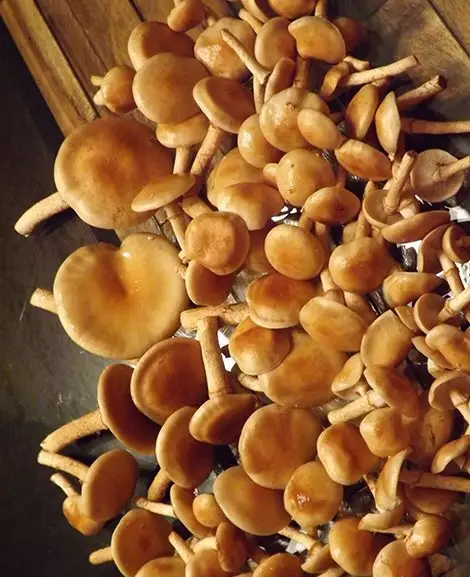The Ultimate Guide to Growing Nameko (Pholiota Nameko) Mushrooms
Nameko (Pholiota Nameko) mushrooms are among the most popular mushrooms cultivated in Japan and increasingly around the world due to their savory flavor, slippery texture, and versatility in soups and stir-fries. These small, amber-colored mushrooms are known for their shiny, gelatinous coating and umami-rich profile, making them a favorite in traditional miso soups and noodle dishes.
In this comprehensive guide, you’ll learn the Ultimate Guide to Growing Nameko mushrooms using both indoor and outdoor cultivation methods. We’ll explore substrate choices, environmental conditions, harvesting techniques, and where to buy reliable spawn—including from The Spore Depot.

What Are Nameko (Pholiota Nameko) Mushrooms?
Nameko mushrooms, scientifically known as Pholiota nameko, are a type of edible fungus native to East Asia. They are typically grown on hardwood logs or sawdust blocks and produce clusters of small, amber-colored mushrooms with a slightly gelatinous cap that gives them their signature slippery texture.
These mushrooms are rich in:
- B vitamins
- Dietary fiber
- Polysaccharides with immune-boosting properties
Due to their unique culinary characteristics and nutritional value, Nameko (Pholiota Nameko) mushrooms have become increasingly sought after in gourmet and medicinal mushroom cultivation. Ultimate Guide to Growing Nameko mushrooms
Why use Ultimate Guide to Growing Nameko mushrooms?
✔ High Market Demand – Especially among Asian cuisine enthusiasts
✔ Unique Texture & Flavor – Mild, nutty, umami-rich profile
✔ Easy to Grow – Suitable for home and commercial setups
✔ Medicinal Benefits – Contains immune-modulating compounds
✔ Long-Term Yield – Logs can produce for multiple seasons
How to Grow Nameko (Pholiota Nameko) Mushrooms
There are two primary methods to grow Nameko mushrooms:
- Log cultivation – Outdoor, longer-term harvests
- Sawdust block cultivation – Indoor, faster yields
Method 1: Growing Nameko Mushrooms on Logs
Step 1: Choosing the Right Logs
The best logs for growing Nameko (Pholiota Nameko) mushrooms are from hardwood trees such as:
- Oak
- Beech
- Maple
- Elm
✅ Logs should be:
- 3 to 8 inches in diameter
- 3 to 4 feet long
- Cut during dormancy (late fall through early spring)
- Aged for 2–3 weeks before inoculation to allow natural antifungal compounds to dissipate
Step 2: Inoculating the Logs
Use Nameko plug spawn or sawdust spawn, both available from The Spore Depot.
🛠 What you’ll need:
- Drill with 5/16” bit
- Plug spawn or sawdust spawn
- Mallet or inoculation tool
- Cheese wax or beeswax
- Wax applicator or brush
🔧 Inoculation process:
- Drill holes 1 to 1.5 inches deep, spaced 4–6 inches apart in a diamond pattern
- Insert the spawn and tap it in firmly
- Seal holes with melted wax to retain moisture and prevent contamination
Step 3: Incubation & Colonization
Store the logs in a shady, humid location, such as a wooded area or under shade cloth.
📍 Conditions:
- Temperature: 60–75°F (15–24°C)
- Humidity: 85–95%
- Incubation period: 9–12 months
💧 Water logs during dry periods or soak in non-chlorinated water for 12–24 hours every few weeks to maintain adequate moisture levels. Ultimate Guide to Growing Nameko mushrooms.
Step 4: Fruiting and Harvesting
Nameko mushrooms naturally fruit in cooler temperatures—usually in late fall or early spring.
To force fruiting, soak logs in cold water for 24 hours, then place them upright in a shaded, humid environment.
🍄 Mushrooms will begin fruiting within 7–14 days.
✔ Harvest when caps are fully formed but not flattened ✔ Gently twist or cut mushrooms at the base
🌳 Logs can produce for 3–5 years, fruiting once or twice annually.
Method 2: Growing Nameko Mushrooms on Sawdust Blocks
For faster and more controlled cultivation, growing Nameko (Pholiota Nameko) mushrooms indoors on sterilized sawdust blocks is an excellent option.
Step 1: Preparing the Substrate
📌 Recommended substrate mix:
- 80% hardwood sawdust (oak or maple)
- 15–20% wheat bran (for nutrients)
- 5% gypsum (calcium sulfate for buffering pH)
- Water to 60–65% moisture content
Mix thoroughly and fill into autoclavable filter patch grow bags. Ultimate Guide to Growing Nameko mushrooms!
Step 2: Sterilization
To eliminate contaminants, sterilize substrate-filled bags using:
- Pressure cooker: 15 PSI for 2 hours
- Autoclave: For larger batches
Allow the substrate to cool completely before inoculation.
Step 3: Inoculation with Spawn
Use grain spawn or sawdust spawn of Pholiota Nameko from The Spore Depot.
🧪 Inoculate under sterile conditions:
- Add spawn to cooled bags
- Mix thoroughly
- Seal and label the bags
Step 4: Incubation
Place inoculated bags in a dark incubation room.
📍 Conditions:
- Temperature: 70–75°F (21–24°C)
- Humidity: 70–80%
- Time: 3–4 weeks for full colonization
White or yellowish-brown mycelium will spread throughout the substrate. Small primordia (baby mushrooms) will begin forming when conditions are right. Ultimate Guide to Growing Nameko mushrooms.
Step 5: Fruiting Conditions
After colonization, move the blocks to a fruiting chamber with the following parameters:
🌱 Fruiting conditions:
- Temperature: 50–60°F (10–16°C)
- Humidity: 90–95%
- Indirect light: 12 hours per day
- Fresh air exchange: 3–5 times daily
Cut an “X” or remove the top of the grow bag to allow mushrooms to emerge.
Step 6: Harvesting and Yield
Harvest Nameko mushrooms when they reach 2–3 inches in height and the caps are still rounded.
⚖ A typical 5-lb fruiting block can yield 1–1.5 lbs of mushrooms over several flushes.
🍄 Gently twist or snip at the base. Clean residual substrate and refrigerate immediately.
Drying and Storing Nameko Mushrooms
🍽 Fresh Nameko mushrooms can be stored in a paper bag in the fridge for up to a week.
🔥 For long-term use:
- Dehydrate at 115°F (46°C) until completely dry
- Store in airtight containers in a cool, dark space
💧 Rehydrate in warm water for 15–20 minutes before using in recipes.
Common Challenges in Growing Nameko Mushrooms
1. Contamination
✔ Sterilize equipment thoroughly
✔ Work in a clean, filtered-air environment
2. No Fruiting
✔ Lower temperature and increase humidity
✔ Ensure sufficient fresh air exchange
3. Drying Out
✔ Mist logs or fruiting blocks regularly
✔ Use humidity tents or chambers if needed
Where to Buy Nameko Mushroom Supplies
Trusted Sources for Spawn, Grow Kits, and Supplies:
- ✅ The Spore Depot – High-quality Nameko (Pholiota Nameko) mushroom spawn, liquid cultures, and kits
- Fungi Perfecti – Comprehensive mushroom cultivation tools
- North Spore – Sterilized substrates and fruiting blocks
Authoritative Growing Resources
For additional information and cultivation techniques, check out:
- Fungi Perfecti’s Cultivation Guides
- The Mushroom Growers’ Handbook
- The Spore Depot Blog – Tips and insights on growing specialty mushrooms
Conclusion: Ultimate Guide to Growing Nameko mushrooms
Growing Nameko (Pholiota Nameko) mushrooms is a satisfying endeavor that yields delicious and highly marketable fungi. With the right conditions, whether you choose log cultivation or sawdust blocks, Nameko mushrooms will reward you with rich flavor, appealing texture, and repeat harvests for seasons to come.
By sourcing your spawn from trusted suppliers like The Spore Depot and following good cultivation practices, you’ll be well on your way to enjoying fresh, homegrown Pholiota Nameko mushrooms! Ultimate Guide to Growing Nameko mushrooms!
#NamekoMushrooms #PholiotaNameko #GrowNameko #MushroomFarming #TheSporeDepot #SpecialtyMushrooms #FungiCultivation Ultimate Guideto Growing Nameko mushrooms.





